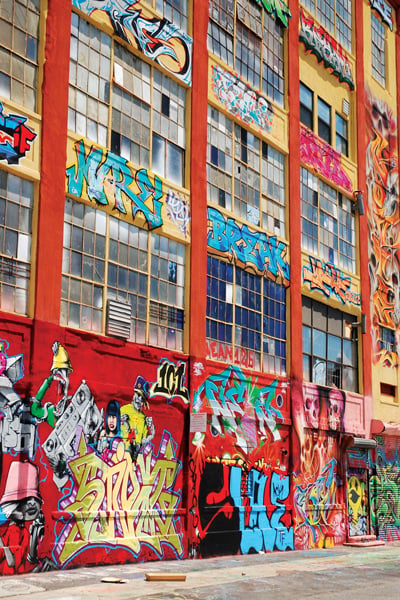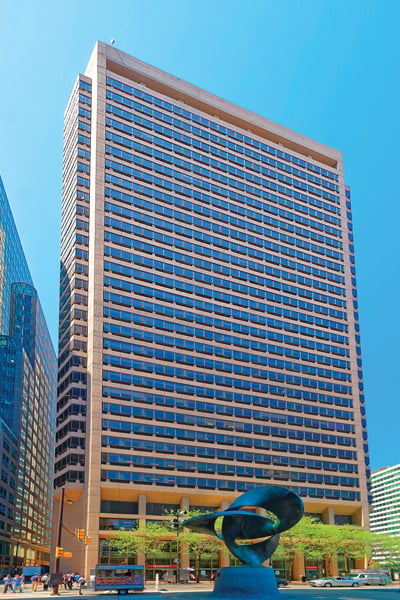Pondering Public Art? Legal Concerns and Artists Rights are Part of the Palette

Developers must balance contracts, intellectual property issues, government involvement and other factors when commissioning pieces for a project.
DEVELOPERS WHO incorporate public art into commercial space find that the second-most-important person in such projects — right behind the artist — is their lawyer.
Public art has become de rigueur at many office buildings and mixed-use development projects because it brings vitality to public spaces. While it’s difficult to prove if art increases project value, there is no doubt that the attention it draws can be a tremendous boon to branding. Art that becomes iconic establishes an identity for a development that often outshines the architecture. This is particularly true for outdoor art such as sculpture and fountains.
But developers, artists, city officials and neighborhood groups sometimes get entangled in legal issues, and lawyers are often called on to help determine the boundaries that balance the rights of stakeholders. Many of these disputes could be prevented with legal advice at the outset. While it’s easy to get carried away with the aesthetics of public art, its creation is transactional. Because of that, everyone involved should be aware of their legal protections.
Ownership May Only Go So Far
Most public art disputes between the developer and the artist revolve around issues of whether the art can be moved, altered or even destroyed. Murals painted on the side of a building, for example, may not fit into a new owner’s plan to redevelop a site.
This situation came up in 2013 when a property owner painted over dozens of graffiti murals at a near-vacant factory building in the New York City borough of Queens called 5 Pointz. The owner had allowed artists to paint on the building’s walls over the years as he rented space to them for studios, and the art became so spectacular that it was a regular stop for tourists. He later had the century-old water meter factory demolished to make way for luxury apartments.
In early 2018, 21 artists were awarded $6.7 million by a federal court following a three-week jury trial. The judgment allocated $150,000 for each of 45 works destroyed at 5 Pointz. Oddly, the judge who calculated the award said the owner was within his rights to tear down the buildings, but he seemed aggravated that the art was whitewashed in the midst of litigation to save it and said the developer might have avoided damages if he had not acted in such haste. The 100-page decision in the case is still being debated and analyzed by the development and art communities, but one takeaway is sure: Developers could pay dearly if they violate artists’ rights.
Basic intellectual property rights also can be an issue. In a case wending its way through U.S. District Court in California, a graffiti artist is suing General Motors Co. because an ad campaign for Cadillac used a Detroit parking deck that featured his painted mural as a background. The artist says GM infringed upon his copyright, and he wants part of the profits generated by the ad campaign.
“Ugly” Versus the First Amendment
Outdoor art also has the problem of succumbing to the elements — inevitably it will need maintenance or restoration. Understandably, artists are prickly about changes that could be made to their work if it is cleaned up or “improved” by others. Owners may assume that after buying art they have the right to treat it as real property and do with it as they please, but artists — and sometimes the law — don’t see it that way. From the viewpoint of artists, their name remains on their works, and any changes could affect their reputation.

The artists who created graffiti murals on a building in the New York City borough of Queens won a lawsuit after the building’s owner had the structure knocked down to build apartments. Photo by istock.com/Kirkikis
One of the first public art cases to go to court focused on “Tilted Arc,” a sculpture commissioned by the General Services Administration to be the centerpiece in the plaza in front of the Jacob K. Javits Federal Office Building in Manhattan. Artist Richard Serra created a 120-foot-long, 12-foot-high, 73-ton rusting steel plate, which was roundly condemned as ugly despite the artist’s explanation that it was meant to be provocative. When the GSA removed it in 1989 with the intention of placing it elsewhere, Serra sued, saying that the mere act of moving a sculpture created for that specific space was destruction. He claimed violations of his First Amendment rights as well as copyright laws and sought $30 million. A court sided with the GSA, citing the artist’s decision to sign over all ownership rights to the sculpture, but the case raised interesting questions about the intersection of artists’ rights in public spaces where the audience — the “public” in public art — does not like it.
In another case, two artists invited to exhibit at the city hall in Pasco, Washington, sued the municipality when their prints and sculpture were barred because of nudity that city employees deemed obscene. With the help of the American Civil Liberties Union, the artists sued on free speech grounds. After the U.S. Court of Appeals for the Ninth Circuit ruled against the city of Pasco, the parties settled, with the municipality making a public apology and acknowledgment of censorship. While this case did not involve a developer, it illustrates the perils of making content-based decisions about public art.
The Moral Rights Hazard
The most important federal law in this area is the Visual Artists Rights Act (VARA), which grants moral rights to artists for works of “recognized stature.” The concept of moral rights might be hard for property owners to accept because they grant artists continuing rights over works that have been sold. The idea behind moral rights is that an artist’s identity remains attached forever to his or her work, and anything that diminishes the work damages the artist’s reputation. VARA bars “intentional distortion, mutilation, or other modification of that work which would be prejudicial to [the artist’s] honor or reputation” and “prevents any destruction of a work of recognized stature, and any intentional or grossly negligent destruction of that work.”
“Recognized stature” is one of those “know it when you see it” qualities that is not defined well in the statute or case law, but developers should assume that any art they would want associated with a building or other development would rise to that status.
However, VARA provides that these rights can be waived by the artist, and that is exactly what is required when buying or commissioning public art. A simple waiver included in the sale agreement or contract for the art negates all rights under VARA. This isn’t because the sensibilities of artists should be respected or the integrity of their work maintained, but because a developer’s first loyalty is the fiduciary duty owed to investors. However worthy the art, it could be disastrous for it to dictate design or financial decisions for a development.
Government May Want to Be Your Art Partner
Government involvement in public art may limit those waivers and complicate other decisions. Some cities require approval of public art, which usually means anything visible from the street. Most of these laws were passed with good intentions and were meant only to prevent patently offensive or commercial works, but they also may be asserted to dictate tastes and to ensure that art fits into the culture of a neighborhood. Inevitably, controversial works become First Amendment issues. If developers have the appetite for this kind of battle, they should push the envelope. If not, they should think carefully about the message or tone of the art and be sure the artist’s vision aligns with the developer’s values.

Since 1959, Philadelphia’s local government has been a leader in developing programs that help support public art such as Robert Engman’s Triune, which is located at 15th Street and South Penn Square. Photo by istock.com/RomanBabakin
Some cities seek to encourage public art by requiring developers to include it in projects. This usually takes the form of “percentage for art” laws that require monetary set-asides for art that are a percentage of the project’s cost. In New York City, municipal-funded construction projects must spend one percent of their budgets for art. Philadelphia is credited with inventing the percentage-for-art concept, and hundreds of art projects have been created there since the law was passed in 1959. There are variations and exceptions to these programs. In some cities, the government must approve — or even commission — public art, while others are satisfied if the developer makes the investment. Cities often provide an easy way out for the faint of heart, allowing developers to donate the art percentage to a government fund that commissions art.
If the local ordinance provides the choice, take as much control as possible. Developers should seek art that maximizes the value of a property, and that goal is not incompatible with wanting to add to a city’s visual beauty.
Be Deliberate and Button Down Contracts
As a practical manner, developers should move with intention when making their art decisions. Create a wide circle of advisers that includes the art community, city planners, neighborhood representatives, and, of course, legal experts. Controversy can erupt over cultural appropriation, the personal background of the artist, and perceived political or social statements, so don’t get blindsided.
Absent contract waivers, the law tilts slightly toward the rights of artists. But the economic power resides with developers, and that means they should not enter into any relationship without waivers that cover a broad menu of things that can go wrong. Art is almost always a buyer’s market. Developers should use that power to protect their interests. Don’t let a $50,000 sculpture hold up a $50 million building.
Despite all the cautionary notes, developers should not be hesitant to embrace public art. Most of it is installed and thrives without controversy and is doing exactly what it is supposed to do — engaging the public, adding vibrancy to cityscapes and branding developments.
Stephanie Friese is managing partner of Pursley Friese Torgrimson in Atlanta.


